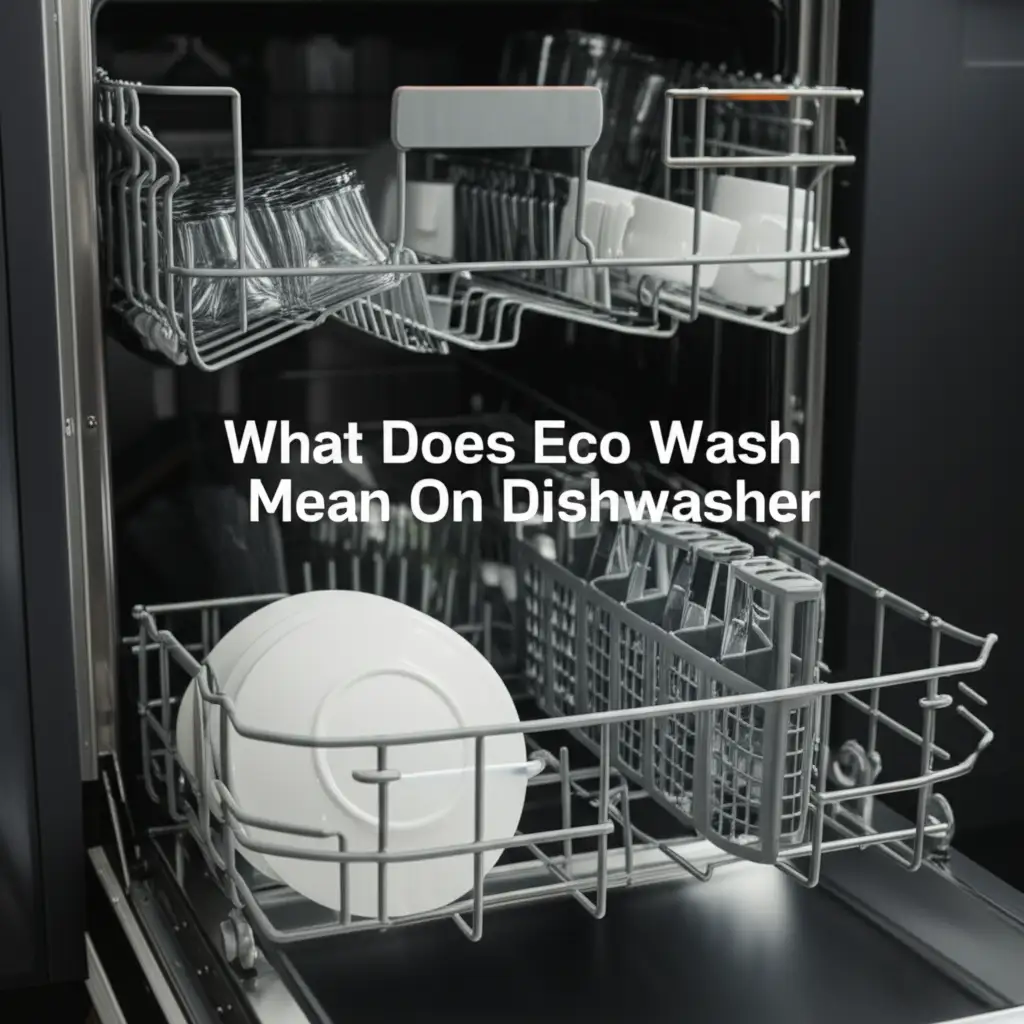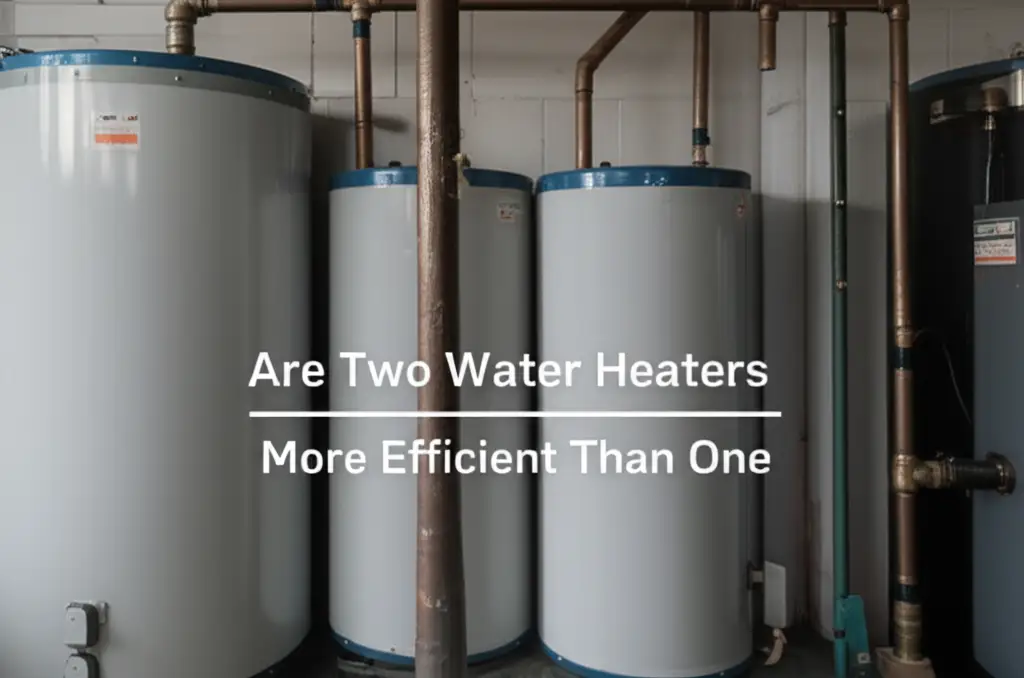· Tessa Winslow · Home Appliances · 15 min read
What Does Eco Wash Mean On Dishwasher

Understanding Eco Wash on Dishwashers: Save Energy & Water
Have you ever looked at your dishwasher’s control panel and wondered, “What does Eco Wash mean on dishwasher?” Many modern dishwashers feature this setting. It promises to clean your dishes while using fewer resources. This cycle is more than just a button; it represents a commitment to energy efficiency and environmental care.
This article explores the Eco Wash cycle in detail. We will uncover how it works to save water and electricity. We will discuss its benefits for your utility bills and the planet. You will learn when this setting is the best choice for your household. We will also compare it with other common dishwasher cycles. By the end, you will understand how to use your dishwasher more sustainably. You will also make smarter choices for your home and the environment.
Takeaway
Using the Eco Wash cycle on your dishwasher offers significant benefits for both your wallet and the environment.
- Saves Energy: It uses lower wash temperatures. This reduces electricity consumption for heating water.
- Saves Water: The cycle often uses less water per wash. This conserves a precious resource.
- Reduces Costs: Lower energy and water use leads to smaller utility bills over time.
- Eco-Friendly: Decreases your carbon footprint by minimizing resource consumption.
- Ideal for Lightly Soiled Dishes: Best suited for everyday loads without heavily crusted food.
- Longer Cycle Time: Expect the cycle to run for a longer duration compared to standard washes. This extended time allows for effective cleaning at lower temperatures.
What Does Eco Wash Mean on Dishwasher?
Eco Wash on a dishwasher means the cycle uses less energy and water compared to standard cycles. It achieves this by washing dishes at a lower temperature and extending the wash duration. This process ensures effective cleaning while reducing your environmental impact and utility bills.
Delving Deeper: What is Eco Wash on a Dishwasher?
The Eco Wash cycle is a special program found on many modern dishwashers. Its main purpose is to reduce resource consumption. It focuses on saving both water and energy. This cycle often goes by other names. You might see it labeled as “Eco,” “Economy,” “Energy Saver,” or “Light Load” on your appliance. No matter the name, the goal remains the same: efficient cleaning with minimal environmental impact.
This mode works differently from a standard wash. A normal cycle might use hotter water and more powerful sprays. The Eco Wash relies on different principles. It uses lower temperatures for washing. This saves the energy needed to heat water. Heating water is a major part of a dishwasher’s electricity use. Instead of high heat, the Eco Wash extends the wash time. It allows detergents more time to break down food particles. This extended soaking and washing action compensates for the lower water temperature. The result is clean dishes without excessive energy use.
For instance, a typical wash might run at 60-65°C. An Eco Wash could operate at 40-50°C. This difference in temperature greatly impacts energy consumption. Think about how much energy it takes to boil a kettle; heating water for a dishwasher is similar. By reducing this heat requirement, the Eco Wash makes a real difference. It is a smart choice for daily cleaning.
You might wonder how effective it is with less heat. Modern detergents are formulated to work well at lower temperatures. They combine with the extended wash time to remove food debris. This means you do not sacrifice cleaning performance. You just use a more gentle, yet effective, approach. Using this setting contributes to a greener home. It is a simple way to make a big difference.
How Eco Wash Cycles Save Energy and Water
Eco Wash cycles are designed for efficiency. They achieve energy and water savings through specific operational adjustments. Understanding these adjustments helps explain their effectiveness. The primary method involves reducing water heating.
Water heating is a significant energy draw for dishwashers. Standard cycles heat water to high temperatures quickly. The Eco Wash cycle operates at lower temperatures. It might use water heated to only 40°C or 50°C. This lower temperature directly cuts down on electricity use. Energy consumption for heating water drops significantly. You can compare this to washing clothes. A 40-degree machine wash uses less energy than a hotter wash. This principle applies directly to dishwashers as well.
In addition to lower temperatures, Eco Wash cycles often use less water overall. They optimize water usage throughout the cycle. This means fewer rinses or smaller amounts of water per rinse. The cycle might also pause more frequently. These pauses allow water and detergent to soak into food particles. This pre-soaking action helps loosen grime. It makes the cleaning process more effective without needing extra water.
The longer cycle time is also a key factor. While it may seem counterintuitive, a longer wash time at lower temperatures is more energy-efficient. It allows the detergent enzymes more time to work. These enzymes break down food residues. This gentle, prolonged action replaces the need for very hot water and intense spraying. It ensures thorough cleaning. You get spotless dishes. You also save on your utility bills.
Consider a normal wash cycle. It might blast dishes with hot water and powerful jets. This provides a fast clean. However, it uses a lot of energy and water. The Eco Wash takes a different approach. It cleans gently over a longer period. This method delivers similar cleaning results. It does so with a lower environmental impact. This makes the Eco Wash a smart choice for daily use.
The Longer Cycle Time of Eco Wash Explained
You might notice that the Eco Wash cycle takes longer than other settings. This extended duration is a crucial part of its energy and water-saving design. It is not a flaw. It is a deliberate strategy to achieve efficient cleaning with fewer resources. A common question I hear is, “Why does it take so long?” The answer is simple: time replaces intense heat and excessive water.
When a dishwasher uses an Eco Wash, it operates at lower temperatures. This means the water does not get as hot as in a standard wash. Lower heat is good for saving energy. However, heat helps break down food and grease quickly. To compensate for this, the Eco Wash cycle extends the washing time. It gives the detergent and water more time to act on the dishes. This allows for a more gentle and gradual cleaning process.
The extended soak time helps loosen stubborn food particles. Water and detergent have more opportunity to penetrate dried-on food. This means the dishwasher does not need to use powerful sprays or very hot water. It achieves cleanliness through prolonged exposure rather than intense action. For example, some quick wash cycles might finish in 30-60 minutes. An Eco Wash could easily run for 2-4 hours. This longer duration means the machine works less intensely per minute. It uses less power at any given moment. This results in lower overall energy consumption.
Many dishwashers, like a Frigidaire dishwasher, have varying cycle lengths. The Eco Wash is almost always their longest option. This extended time is not wasted. It is actively working to soften food and dissolve grease. It does this efficiently, without high heat. So, while you wait longer for your dishes, you are also making a conscious effort to conserve resources. This trade-off of time for efficiency is key to the Eco Wash’s effectiveness.
When to Use the Eco Wash Cycle for Best Results
The Eco Wash cycle is not for every load. Understanding its ideal use cases ensures you get clean dishes while maximizing its benefits. This cycle shines when you have lightly to moderately soiled dishes. It is perfect for everyday use.
Consider using Eco Wash for:
- Daily Dinnerware: Plates, bowls, glasses, and cutlery from a typical meal are ideal. These items usually have fresh food residues. They do not require aggressive cleaning.
- Breakfast Dishes: Cereal bowls, coffee cups, and toast plates are perfect candidates. They have minimal dried-on food.
- Lunch Items: Sandwiches, salads, and light meal dishes fit well. These items are rarely heavily soiled.
- Dishes Washed Regularly: If you run your dishwasher every day or every other day, food does not have time to harden. This makes Eco Wash highly effective.
Avoid using Eco Wash for heavily soiled items. This includes pots and pans with baked-on food or dishes with thick, dried sauces. For these items, a heavy or intensive cycle is more appropriate. The lower temperature and gentler action of Eco Wash may not effectively remove stubborn grime.
It is also great for certain delicate items. Items like silicone mats or specific plastics that are dishwasher safe benefit from lower temperatures. High heat can sometimes warp or damage sensitive materials. The Eco Wash offers a gentler cleaning environment. You can even wash some items like gas stove burners in your dishwasher if they are safe for it, and the eco cycle might be suitable if they are not excessively greasy.
To get the best results, scrape off large food particles before loading. This is good practice for any cycle. It is especially helpful for Eco Wash. Pre-scraping ensures the cycle can focus on dissolving smaller residues. This optimizes its cleaning power. Using the Eco Wash consistently for appropriate loads significantly reduces your household’s energy and water footprint.
Comparing Eco Wash with Other Dishwasher Cycles
Dishwashers offer various cycles. Each cycle serves a different purpose. Understanding the differences helps you choose the right setting for your load. Let’s compare Eco Wash with common alternatives.
Normal Wash Cycle
The Normal wash cycle is the standard default. It is designed for everyday loads with average soil levels.
- Temperature: Uses hotter water than Eco Wash, typically around 55-65°C.
- Water Usage: Uses more water than Eco Wash.
- Cycle Time: Shorter than Eco Wash, usually 90-150 minutes.
- Energy Use: Higher than Eco Wash due to more hot water and shorter cycle time.
- Best For: Regular loads with mixed soil levels.
Quick Wash Cycle
The Quick wash cycle, also known as “Express” or “Rapid,” is for lightly soiled dishes that need a fast clean.
- Temperature: Can use high temperatures, but some focus on speed over heat.
- Water Usage: Often uses more water per minute than other cycles. This is because it tries to achieve fast cleaning. Learn more about if a quick wash uses less water.
- Cycle Time: The shortest cycle, typically 30-60 minutes.
- Energy Use: Can be surprisingly high. While short, it often compensates with intense heat and spray pressure.
- Best For: Lightly soiled items you need quickly, like entertaining dishes between courses. It is not suitable for dried-on food.
Heavy/Pots & Pans Cycle
This cycle is for heavily soiled items, baked-on food, and pots and pans.
- Temperature: Uses the highest temperatures, often above 65°C.
- Water Usage: Uses the most water. It often includes multiple rinses and longer spray times.
- Cycle Time: Can be as long as, or even longer than, Eco Wash, but with intense action. Typically 2-4 hours.
- Energy Use: The highest energy consumption due to extreme heat and water use.
- Best For: Tough jobs, like casserole dishes, greasy pans, or very dirty loads.
Eco Wash in Context
Eco Wash sits uniquely among these. It prioritizes efficiency over speed or intense power. It uses less energy and water. It relies on a longer wash time at lower temperatures. It achieves clean dishes for typical loads. While it is not the fastest, its environmental and economic benefits are significant. Choosing the right cycle helps you manage your household resources effectively.
Maximizing Eco Wash Effectiveness and Tips
Using the Eco Wash cycle effectively involves more than just pressing a button. A few simple practices can significantly improve its performance. These tips ensure your dishes come out sparkling clean every time. You also get the full benefit of energy and water savings.
First, scrape off large food particles before loading dishes. The Eco Wash relies on extended soaking and lower temperatures. It is not designed to power through big chunks of food. Removing these helps the dishwasher focus on dissolving smaller residues. This prevents clogs and ensures better cleaning. You do not need to pre-rinse, just scrape.
Second, load your dishwasher correctly. Proper loading allows water and detergent to reach all surfaces. Do not overcrowd the racks. Overloading prevents water jets from reaching every dish. It can lead to incomplete cleaning. Make sure items are not nested together. Arrange them to allow free flow of water. This is especially important for the gentler Eco Wash.
Third, use the right detergent. Modern dishwasher detergents are formulated to work well at lower temperatures. Many contain enzymes that are active even without very hot water. Choose a high-quality detergent. Look for ones marketed for “low temperature” or “eco-friendly” washing. Avoid using too much detergent; this can leave residue. Follow the manufacturer’s recommendations for dosage.
Fourth, clean your dishwasher regularly. A clean dishwasher works more efficiently. Check the filter at the bottom of the tub. Remove any trapped food particles. Run an empty cycle with a dishwasher cleaner or vinegar occasionally. This removes grease and limescale buildup. A clean machine performs better on any cycle, including Eco Wash.
Lastly, consider air-drying if your dishwasher has this option. Many Eco Wash cycles skip the heated dry phase to save even more energy. If your machine offers it, select an air-dry or simply open the door after the cycle finishes. This allows residual heat to evaporate moisture. This final step further reduces energy consumption. By following these tips, you can maximize the effectiveness of your Eco Wash. You enjoy perfectly clean dishes and a greener home.
Environmental and Economic Benefits of Eco Wash
Choosing the Eco Wash cycle does more than just clean your dishes. It delivers significant benefits for both the environment and your wallet. These advantages make it a truly sustainable choice for modern households.
From an environmental standpoint, the Eco Wash cycle reduces your carbon footprint. Dishwashers are major home appliances. They use considerable amounts of energy and water. By cutting down on hot water usage, the Eco Wash directly lowers electricity consumption. Less electricity use means less demand on power grids. This often translates to fewer greenhouse gas emissions from power plants. It also conserves valuable water resources. In many regions, water scarcity is a growing concern. Using less water contributes to sustainable living and protects local ecosystems. Every load run on Eco Wash makes a difference. It is a small but meaningful step toward a more sustainable lifestyle.
Economically, the benefits are clear on your utility bills. Lower energy consumption for water heating translates to lower electricity costs. Similarly, using less water reduces your water bill. Over time, these savings add up. A household that consistently uses Eco Wash for appropriate loads can see noticeable reductions in their monthly expenses. While the initial savings per wash might seem small, the cumulative effect over a year or several years is substantial. This makes Eco Wash a smart long-term investment for your budget.
Furthermore, using gentler cycles can prolong the life of your dishwasher. Less exposure to extreme heat and intense water pressure may reduce wear and tear on internal components. This could mean fewer repairs and a longer lifespan for your appliance. This indirect benefit also saves money and reduces waste. It promotes a circular economy.
Embracing the Eco Wash cycle is a simple way to practice responsible consumption. It aligns with broader goals of sustainability and energy conservation. It shows that convenience and environmental responsibility can go hand in hand. By choosing Eco Wash, you contribute to a healthier planet and a healthier budget.
FAQs About Eco Wash on Dishwashers
Is Eco Wash good for really dirty dishes?
No, Eco Wash is not ideal for heavily soiled dishes or baked-on food. Its lower temperature and gentler action are better suited for lightly to moderately dirty items. For tough grime, you should select a “Heavy” or “Pots & Pans” cycle.
Does Eco Wash clean dishes well?
Yes, Eco Wash cleans dishes well for appropriate loads. It uses a longer cycle time to compensate for lower water temperatures. This allows detergents more time to work on food particles. It ensures effective cleaning for daily dinnerware and glasses.
How long does Eco Wash take?
The duration of an Eco Wash cycle is typically longer than standard cycles. It can range from 2 to 4 hours, depending on the dishwasher model and load sensors. This extended time is crucial for efficient cleaning at lower temperatures.
Is Eco Wash always the best option?
No, Eco Wash is not always the best option. While it saves energy and water, it is best for light to moderate loads. For very dirty dishes, or when you need dishes quickly, other cycles like “Heavy” or “Quick Wash” are more suitable.
Can I use any detergent with Eco Wash?
Most modern dishwasher detergents work well with Eco Wash. Many are formulated to be effective at lower temperatures. For optimal results, you can look for detergents specifically labeled for “eco” or “low temperature” washing. Always follow the detergent manufacturer’s dosage recommendations.
Does Eco Wash completely dry the dishes?
Some Eco Wash cycles skip the heated drying phase to save energy. This means dishes might be slightly wet at the end of the cycle. You might need to air-dry or open the dishwasher door after the cycle finishes. This allows residual heat to dry the dishes naturally.
Conclusion
Understanding what Eco Wash means on your dishwasher empowers you to make smarter choices. This cycle is a testament to how home appliances evolve to meet modern demands. It helps us save energy and water. It offers a practical solution for daily cleaning. You get clean dishes while contributing to a healthier planet.
By embracing the Eco Wash cycle, you actively reduce your household’s environmental footprint. You also lower your utility bills. This simple choice reflects a commitment to sustainable living. Remember, while it takes a bit longer, the benefits of using less electricity and water are significant. We encourage you to use the Eco Wash cycle for your everyday loads. Make it a regular part of your home routine. Your wallet and the environment will thank you.





